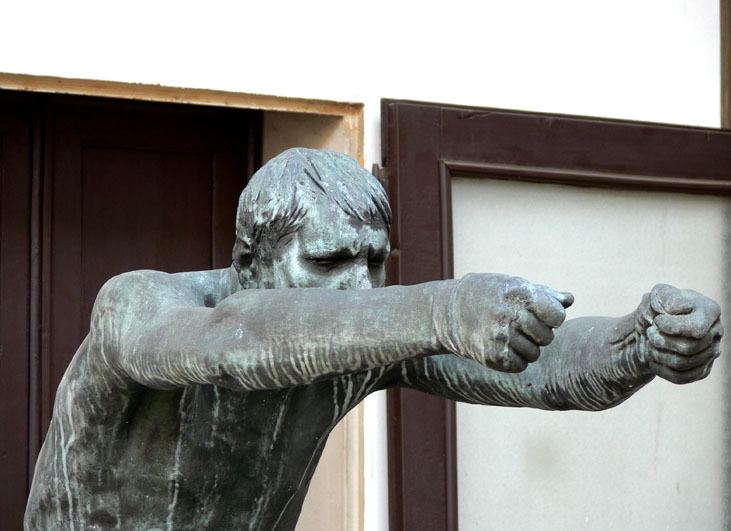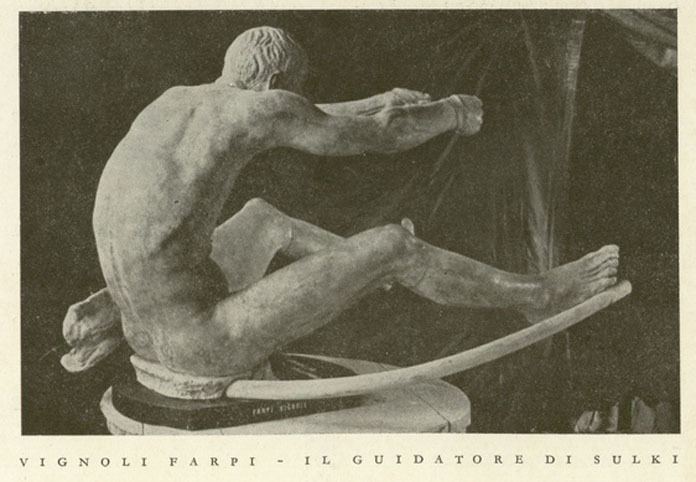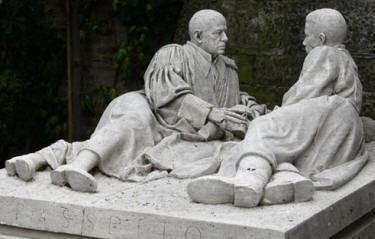Name Farpi Vignoli | ||
 | ||
Died November 1997, Bologna, Italy | ||
Farpi Vignoli (August 21, 1907 – November 1997) was an Italian sculptor. He was born and died in Bologna.
Contents

Biography
Farpi Vignoli was born in Bologna in August 1907 (where he will live up to November 1997), from Callisto Vignoli, a carpenter, and Ersilia Tagliavini. He was the younger of three brothers. (The first name, unusual, born from a longer name that his father was tring to compose). It spends the infancy and the first adolescence in a house near the racecourse of the Arcoveggio (from which the inspiration for the Il guidatore di sulki" (The Sulky Driver) and then for the horse). In 1919 he was admitted to the College Venturoli, where he studied painting, sculpture, architecture following sculptor Enrico Barberi's teachings. In this period a brotherly friendship was born with Paolo Manaresi. In the same period the friendship with the sculptor Luciano Minguzzi was consolidated, as he they continued in the Academy with the same teacher Ercole Drei, then busy in the realization of the marmoreal Images of Liberty and Victory for the Chartreuse in Bologna. Concluded then the Art Academy, in 1934 he begins in Bologna with a personal exposition.

In the II Quadriennale in Rome, in 1935 (on invitation of the founder Cipriano Efisio Oppo), the The Sulky Driver was awarded the right to participate to the Olympiads in Berlin in 1936. During the following years: the Tennis player in 1936; the Shot of rope in 1937; the Jumper in 1938, this last suggestively suspended between sky and earth with an unusual equilibrium of oblique auctions.
In 1936 he won the gold medal in the art competitions of the Olympic Games for his "Guidatore di sulky" ("The Sulky Driver").
Then Vignoli changes style and abandoned the sporting subject. In 1939, he introduced to the III Quadriennale, in Rome, the prelude of love opening a new period of creativeness more eclectic. In the same years he realized two gigantic bas-reliefs for façade of the Farmer's House (today Chamber Federate of Job) in Bologna. In 1940 wins (with Four Horses) the façade of EUR, in Rome, and then two great trophies for the same complex. In 1941 the portrait of a friend: the poet Alfonso Gatto.
The resumption of the activity
In the immediate postwar period, the new generations mature the rebellion against the preceding period. In this phase Vignoli devoted himself with passion to the watercolor painting (his favorite technique, since college), surprisingly innovating its chromatic and materic principles, reaching brightness and tones, more allied with the technique of the fresco, to the point that Virgilio Guidi defined the result: a true ransom toward the other nobler techniques.
Vignoli returns to the sculpture from the 1950 with various works: Grave Frassetto, in the Chartreuse in Bologna; the portraits of American actors (among which were Tyrone Power and the director Henry King); Grave Ennio Gnudi (Mayor of Bologna in the 1920), always in the Chartreuse; the bronzy Monument to the Bersaglieris fallen in Russia (Bologna); his Mother and others. In 1957 he planned and directed the construction of the architectural complex for the Art Academy in Bologna, compreending the Theater for the School of Scenography, very appreciated by architect Gabor Acs. Then new errands of sculptures: The Stele to the cripples of war bronze (Park S. Violet, Bologna), the Monument of St. Francis and the wolf (Gubbio), bronze; the Ciborium of the Cathedral of Casalecchio, natural bronze ; Mariarosa, the young teacher , marble (Chartreuse); the Horse (Castel S. Pietro), bronze great to the truth. In the last period of activity, among 1980 and 1990, the new sporting subjects, in bronze: Hang-gliding, Windsurfer, Giacomo Agostini, Björn Borg, Motocross.
Other artistic events
Bibliographical signs
We can find first useful elements for reconstructing the artistic personality of Vignoli in the anthology of Eugenio Riccoboni of the 1942 Rome in the art. The sculpture in the modern age , and, subsequently, in the book of Francesco Sapori of the 1949 on his Modern Italian Sculpture .
